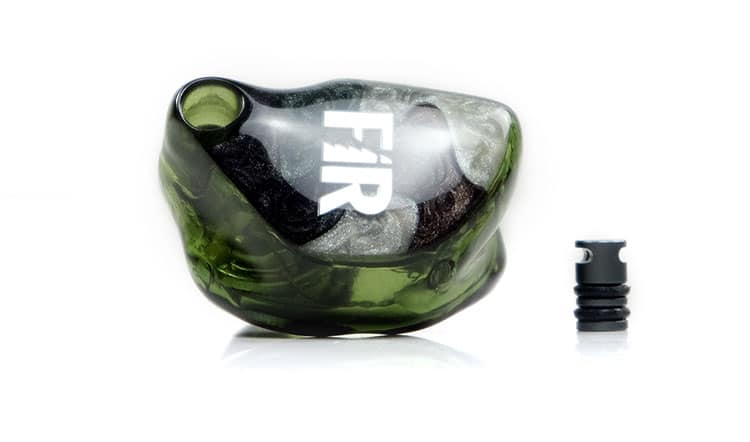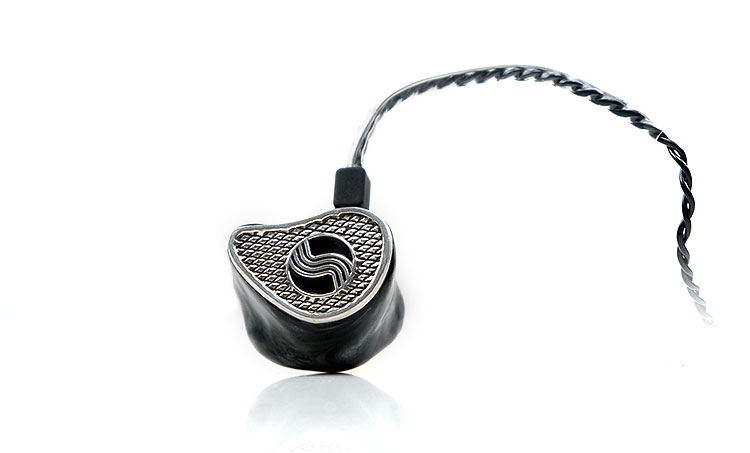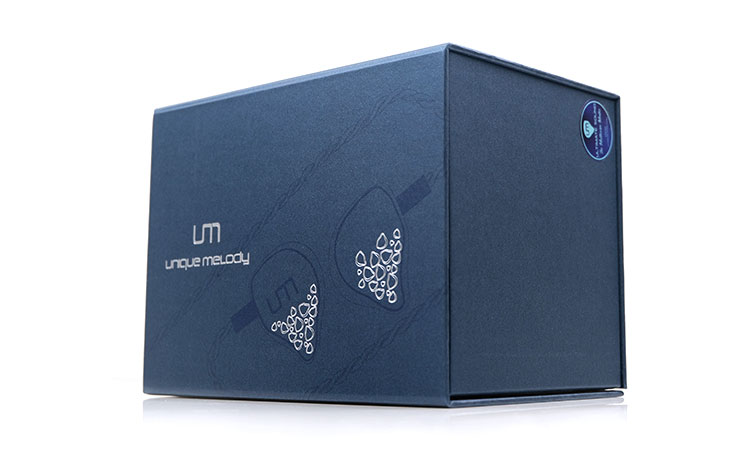Select Comparisons
Unique Melody Maven Pro
$2999
The Maven Pro was recently released in both universal and custom formats and is technically the next level down price-wise from the Multiverse Mentor. You can read our full review of the Maven Pro here.
Technical
Unlike the Multiverse Mentor, the Maven Pro uses a mix of BA drivers and EST though both do not use any dynamic drivers. The Maven Pro does lack bone conduction whereas the Multiverse Mentor has a Frequency Shift piezoelectric bone conduction driver.
The monitors are 12 drivers per side however, the Maven Pro uses 10 non-vented balanced armature drivers with the final two being EST, whereas the Multiverse Mentor is an all-BA configuration.
The precise grouping for the Maven Pro is 4 larger woofer armature drivers for the lows, two full-range drivers for the mids, and a quad pack of BA drivers for the highs up to around 8-10k. The 2 EST drivers provide an additional response layer for the ultra-highs beyond 10k with a 4-way crossover.
The Multiverse Mentor uses a 5-way crossover but a similar 4 BA drivers for the lows and 4 for the mids instead of 2 with the final 4 for the highs and ultra-highs.
The Maven Pro has an impedance rating of 30Ω and 112 dB SPL @1KHz compared to the Multiverse Mentor’s 22Ω and 114 dB SPL @1KHz so it is marginally easier to drive with the EST drivers in the Maven Pro the usual culprits here in terms of dragging down the efficiency levels.
Design
I am in two minds on which design I prefer despite the Multiverse Mentor being the more expensive of the two custom formats. Titanium is a theme here and the Maven Pro uses a heck of a lot more of that durable material compared to the Multiverse Mentor’s titanium frame.
Granted, the Banksia Seeds artwork and carbon fiber blue shells have a bit more pop to their aesthetic but an entire shell from titanium is no mean feat and explains why the custom version of the Maven Pro is a lot more expensive compared to the universal format.
Both feel durable but the titanium shells of the Maven Pro feel incredibly solid and robust. The Multiverse Mentor is the lighter and volumetrically the small of the two creations though and you will feel that weight difference in the ear.
Apart from that the comfort levels are the same as are the levels of passive isolation given they are custom designed of the same STL scan of my ear and have no venting requirements. Both are outstanding in that category.
One final difference is the stock cable. The Multiverse Mentor Deep of Universe cable feels and looks more luxurious though with slightly higher levels of microphonics.
Both are 4-core though it might surprise you to know that the M2 cable used by the Maven Pro is a thicker 24AWG compared to Deep’s 26AWG rating. The Deep materials, however, are a little more complex with independently shielded ultra-pure copper and silver-plated copper wire compared to just OCC copper inside the M2.
Performance
You would be hard-pressed to understand the technical and textural differences between these two simply by looking at the various measurements out there. They both seem to be offering a similar mildly w-shaped curve with heightened mid-bass, pinna gain, and some mid-treble bumps.
The only glaring measurement difference is the Maven Pro’s more exaggerated mid-to-upper-bass bloom which is relatively easy to pick up when comparing them side by side.
However, the experiential side is hugely different. Going from the Maven Pro to the Multiverse Mentor is the equivalent of upgrading from an excellent stereo 2.1 room system to a 5.1 or even a 7.1 speaker setup.
The staging complexity, particularly the depth and width of the Multiverse Mentor is massively expanded compared to the Maven Pro. It makes the Pro sound like, well, a regular IEM, all front, and center whereas the Multiverse Mentor improves the bass to mids separation, pushes out the stereo image far wider, and delivers something far more holographic.
The crazy thing though is the texture on the low-end notes. Bone conduction makes a difference here for me giving the Multiverse Mentor bass texture a lot more natural detail. It also seems to extend a bit deeper.
The Maven Pro bass is tight, as punchy in part also but lacks the saturation and girth of the Mentor equivalent. The bottom weight of the Mentor bass notes is just so much more palatable giving bass guitar plucks, kick drum, and synth instruments improved definition and power.
Vocals imaging is a shade back for me on the Mentor compared to the Maven Pro’s more intimate and forward presentation. You also hear a bit more EST influence on the Maven Pro upper-mids whereas the Multiverse Mentor’s all-BA timbre is a bit smoother and more natural to my ear.
FiR Audio Krypton 5
$2999
The Krypton 5 was launched early last year with the custom version reviewed by us just before Xmas. It was also our co-awardee Top Gear Award winner for best Custom IEM for 2022. Testing was done with the stock silver ATOM filter.
Technical
The Krypton 5 driver count is much smaller but the mix is more exotic and yes, like the Multiverse Mentor, the Kr5 uses a hybrid bone conduction technology.
It uses 5 drivers with a single 10mm dynamic, 4 tubeless or OpenDriver BA with hybrid bone conduction. The Multiverse Mentor up the count massively to 12 BA per side with the additional bone conduction driver.
The Multiverse Mentor’s frequency shift bone conduction driver is less focused on a specific region and more intent on adding flavor across the entire audible range. Whereas the Krypton 5 driver is a hybrid focus on the lows and packaged as “Kinetic Bass”.
The hybrid aspect is porting the dynamic driver to the exterior of the shell allowing low-end notes to be transmitted directly to the ear cartilage and surrounding area in the form of kinetic energy that travels to the inner ear via bone conduction.
The other key design difference is the use of filters or the ATOM module inside the Kr5 which regulates pneumatic pressure from sound waves and ideally helps prevent damage to your hearing. It also can shape the performance in terms of the amount of bass response and the level of passive isolation by up to 17 dB.
Design
Again, both are custom samples so the final design is always flexible and you should find the fit to be correct based on your ear molds or STL scans.
That being said, I do detect some slight fitting differences between the Krypton 5 and the Multiverse Mentor samples I have here. The UM design feels firmer in the ear and I do wonder if that is to do with the slightly larger external body combined with the titanium frame. The Krypton 5 feels a little lighter and sits flusher in the ear.
The Multiverse Mentor does isolate better but that should not be a surprise given the Krypton 5 is a vented shell due to its use of a dynamic driver. It will isolate even less once you start using the m15 and mX modules which reduce the dB isolation relative to the m20 module.
Aesthetics? Well, this is the unusual versus the traditional. The Krypton 5 uses a lighter translucent green shell with a complementary camo faceplate to give it a homogenous natural vibe whereas the Multiverse Mentor goes for a contrast of carbon fiber blue with that Banksia seeds plate and titanium frame.
I am relatively on the fence about which one I prefer, I think there will be fans of each design and it might come down more to the level of isolation and comfort levels as described above.
One thing to note is the 4-core 26AWG Deep Of the Universe cable which looks far more opulent and cool than the 48″ 26AWG SPC ‘Scorpion’ wire from the Krypton 5 though the FiR Audio larger 8-wire might offer lower levels of resistance.
Performance
Two high-end monitors with bone conduction going in very different directions with differing strengths and weaknesses.
In a nutshell, the Krypton 5 is the more ‘colored’ of the two and will appeal to those wanting an aggressive and weighty sound signature. The Multiverse Mentor has a more balanced and flexible tuning with a superior imaging experience.
No question that the Krypton 5 has a stronger and more physical bass response. When a good quality bone conductor and dynamic driver are paired well the performance is going to out slam and overpower the BA and bone conductor equivalent.
The Multiverse Mentor has a surprisingly good level of texture and weight with an excellent punch and against some mere average dynamic drivers, it will come very close to mimicking that slightly elongated level of decay and excellent weight.
However, the Krypton 5 low-end combo is just so concussive in both depth and punch that it more or less dominates everything else once it starts being pushed. That is a pro and a con depending on your musical preferences and none more so in the mids where the Multiverse Mentor sounds more open and resolving.
The Krypton 5 can sound good and clear on the 1-2k region if the lows are not pushing hard but otherwise, it’s a darker tone from 2-4k compared to the more open and expansive mids imaging of the Mentor.
No question either on headroom, the Multiverse Mentor stretches much taller and wider so what it lacks in comparative depth to the Krypton 5 it more than compensates with improved airiness and height.
JH Audio Sharona
$2299
The Sharona is JH Audio’s flagship custom in-ear monitor and one which we reviewed in detail earlier in 2022. It is also our co-awardee Top Gear Award winner for best Custom IEM in 2022.
Technical
Both of these use the BA driver as their mainstay, however, the Sharona has no additional bone conduction driver.
What it does have is 16 drivers per side, 4 more than the Multiverse Mentor as well as using Knowles’s new RAU super-tweeter drivers for the highs and ultra-highs, (12kHz to 25kHz). The RAU drivers are supposed to deliver more extension and headroom than typical BA tweeters to match EST driver performance.
Using JH Audio’s customary Freq|phase and Soundrive™ Technology mini quad drivers configuration with a 4-way integrated crossover you have 4 driver groupings.
That means 4 quad driver packs with a set of woofers for the lows, a quad of full-range drivers for the low-mids, a set of tweeters for the high-mids, and the final array is a set of those RAU Quad Supertweeters.
The Multiverse Mentor has a more complex 5-way crossover configuration and also has 4 BA drivers for the lows. Its mids have 4 instead of the 8 inside the Sharona and the final 4 drivers cover the highs and ultra-highs. It also has the Frequency Shift bone conduction driver which gives its BA driver tonality a slightly different textural quality.
The Sharona is rated at 14Ω and 114 dB @ 1mW SPL and compared to the Multiverse Mentor’s 22Ω and equal 114 dB @1mW SPL there is not much difference between these two for sensitivity on paper.
Design
I find a lot of similarity in the approach to custom designs between JH Audio and Unique Melody, exemplified by the heavily engineered finishing to both the Sharona and the Multiverse Mentor.
Now, before, in the case with the Jolene, I would have said that the JH Audio custom design is by far the bigger of the two and they have always been known for making big monitors due to their internal tubing requirements.
The Sharona, however, is much smaller, something JH Audio has been working on recently in reducing their IEM sizes. I would say it is narrower than the Multiverse Mentor but still a bit deeper so it will sit out of your ear a bit more.
The fit is also a little more relaxed on this sample of the Sharona though, to be honest, maybe too relaxed with the Multiverse Mentor’s slightly beefier nozzle finish offering a slight edge in passive isolation.
Aesthetically, the Sharona is on par. Both monitors look great, unique, and eye-catching. However, bear in mind that this is one of many Signature designs offered by JH Audio so it is not fixed in stone.
I will say though I would prefer to go with the 7-pin connector system over the IPX connector on the Sharona. Not that IPX is bad, in fact as a system I think it’s better than the 7-pin for easy connection. However, you do lose the bass module option, and because it is a recessed thin port, it’s very hard to roll.
With the stock Deep’s 2-pin 0.78mm standard format for the Multiverse Mentor, you should have no such issues as one of the most common connector types.
Performance
Both of these monitors share an ability to create a very big staging quality but therein they lay out both the coloration and the complexity of the imaging in a very different manner.
For me, the Multiverse Mentor delivers a bit more variety in its coloration and note texture. For a start, the bone conduction completely changes the quality and texture of the lows when compared to the Sharona.
The JH Audio bass tuning has more amplitude and upper-bass bloom but lacks the solidity and textured detail of the equivalent range in the Mentor. So, you get volume and body with the Sharona but you get improved definition and a more realistic level of slam and decay with the Mentor.
You also get a better sense of space and layering around each note from the Mentor. There is a more substantial upper-bass to lower-mids scoop in the Mentor’s FR which drains a lot of that potential bloom away giving notes more room to breathe.
The Sharona is beautifully smooth through the mids with a slight vocal bump but its relaxed treble presence combined with that enhanced bloom bass gives instrumental note texture a fairly consistent even-harmonic rounded tonal quality throughout. It makes for a very relaxing listening experience.
The Mentor ups the mid-treble presence around 8k which gives instrumental harmonics a stronger upper-order presence and a little more urgency for me. Percussion hits will have improved energy and sparkle in the upper mids also and some higher-pitching vocals will sound a little cleaner in their timbre.
Our Verdict
If ever there is a BA custom monitor that will give die-hard high-end dynamic driver fans pause for thought then the Unique Melody Multiverse Mentor is likely the one that will come the closest to doing that.
It’s an absolute tour de force in delivering a darn near perfect tonal quality, an exemplary immersive holographic staging quality with pinpoint accurate imaging. The crazy thing is that it sounds so natural to the ear despite being so technically brilliant.
Quite often monitors that try to stretch everything out sound either too thin, bright, or bloated on the low end. You get nothing like that here. It sounds wonderfully coherent, almost too darn perfect dammit, we want flaws and I can find very little of that here, at least sonically.
Externally, it’s a custom monitor and fits perfectly with superb isolation. Aesthetically, the mismatch between the website’s graphical artistry and reality might disappoint some but nevertheless, it is well-engineered.
The benchmark for 2023 for a multi-BA custom monitor performance? So far yes, and beyond BA for that matter also. This will be a tough one to beat for sure.
Unique Melody Multiverse Mentor Specifications
- Headphone type: BA+ frequency shift bone transducer
- Number of drivers: 12+1 drivers
- Socket: 2-pin socket
- Sensitivity: @1KHz 114 dB
- Impedance: 22Ω
- Frequency range: 20Hz-40kHz
- Crossover: 5-way crossover
- Configuration: 4 bass drivers + 2 mid-range drivers + 2 mid-high drivers + 4 high-frequency drivers + 1 frequency shift bone transducer
- Cable: Deep Of Universe Custom Cable








